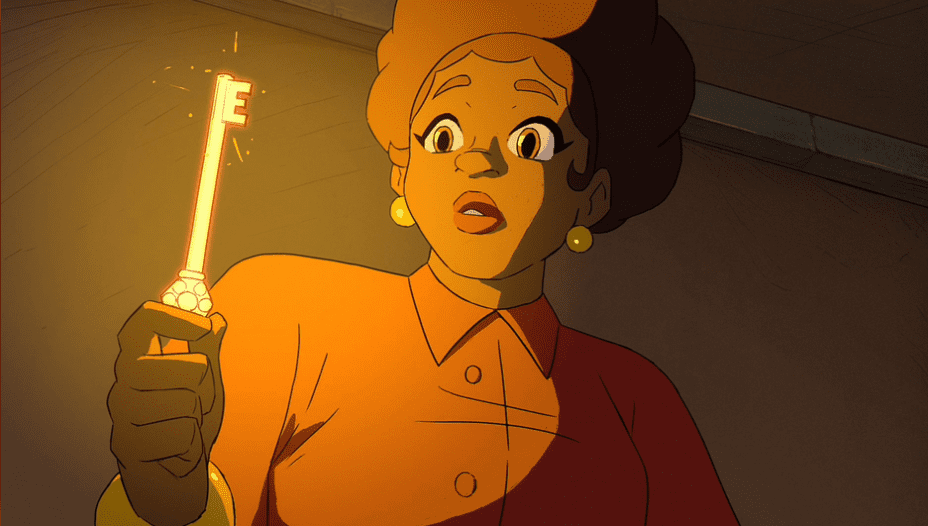Dot’s Home is a free, narrative-driven video game produced by the Rise-Home Stories project, a collaboration between housing justice advocates and various artists, writers, and other professionals. The game aims to address hyper-individualist and scarcity-focused narratives around housing and communities.
The player plays as Dot, a young woman in her 20s who lives with her grandmother and nephew in a neighborhood where developers are hungry to flip homes. She wakes up from a nap with an unfamiliar glowing key attached to her key chain and the door to her bedroom locked.
This begins a journey across time where the player must help Dot find her way back home, meeting members of Dot’s family during various points in history as they wrestle with many forms of racism when searching for homes. The player gets to influence housing decisions for various relatives.
The game is beautifully animated. As someone who grew up in the early 2000s on educational PC games, I found the 2-D art style reminiscent of classics like Jump Start, Where in the World is Carmen San Diego, and other children’s adventure games, but with an updated flair for the 2020s. Every level and scene is bursting with bright colors. The animated introductory scene has gorgeous lighting that really helps draw the player into the game. And while the music is simple, the upbeat rhythm pairs well with the cheery colors. The quality and detail in the animation, art, and sound is impressive.
It’s the bright, detailed design that keeps the game light-hearted, making it a good potential resource for educators who want to introduce students to the issues of fair housing. I could definitely imagine a teacher taking their class to the computer lab over the course of two days to play the game and hold a discussion afterward. It took me about 45 minutes to play the game the entire way through, so its brevity can be seen as an asset.
At the same time, part of me wishes it was longer so that it could explore more nuance.
The game does a decent job teaching housing issues. It avoids hitting the player over the head with historical facts, though little newspaper articles can be found lying on the ground on each level that the player can click on, which provides more specific information about each time period and its relevant housing issues. Dot’s Home opts instead to focus on the human side of housing injustice instead of giving meticulous explanations about history and policy.
[RELATED ARTICLE: Redlining and Mental Health—Connecting the Dots Across Poverty, Place, and Exclusion]
Dot’s Home is one of a popular type of video game where the player’s choices matter. The controls are very simple. It’s a point-and-click game that relies almost entirely on story and dialogue. While the only choice that older games typically gave players was which bad guy to shoot, popular games such as The Walking Dead or Life is Strange give players sets of dialogue choices when they encounter characters in the game. Their choices can affect the direction of conversation, the attitudes of another character, the ending, or even the entire course of the story. A notable comparison would be to the old-school “Choose Your Own Adventure” books. The main strength of this type of game is immersion. The games convey their messages through the emotional responses of other characters to the player’s choices, thus making players feel responsible for those actions. Therefore, in order for these types of games to be effective, good writing and character development are essential.
But Dot’s Home doesn’t fully take advantage of that game format. Much of the dialogue comes off a bit cheesy or bland. None of the characters are particularly memorable, and they feel more like vessels for a message than complex people. The player spends so little time with other characters before being whisked away to another time period that it is difficult to develop feelings for any of them. Due to this briskness, the interactions feel shallow and the scenes feel rushed, with characters willing to divulge a surprising amount of personal information to a protagonist they only just met.
Because of this, the stakes in the game never feel pressing. Because the characters do not stand out, I found it difficult to form emotional connections to them, so the creators lose out on the opportunity to communicate the emotional, human costs of housing injustice and discrimination. It might have been better to limit the number of time periods that Dot traveled to in order to spend more time exploring one particular issue, getting to know certain characters better and the toll that those housing issues levied on them personally.
Another major missed opportunity is the limited impact of the player’s choices. Like other choice-driven games, Dot’s Home gives the player multiple opportunities throughout the game to speak to and influence characters. However, the decisions don’t feel like they have weight.
Of course, that could have been an intentional decision. Historically, people of color have often lacked any choice in their housing options due to both explicit and subtle racism that was built into government policies and programs. By having a negative outcome regardless of the player’s choice, the game developers could effectively communicate a feeling of powerlessness in the face of large institutions.
However, that’s not the case. When the player is presented with the option of either advising the grandparents to immediately buy a home through a contract with questionable terms or rent until they can better afford it, either way the grandparents eventually get the house. Whether the player advises the parents to stay in public housing or find a home in the suburbs, they still end up moving to the suburbs. Surely the outcomes of those major decisions would be very different. And it begs the question: what lessons will a player who is unfamiliar with the history of racist housing policies draw from this game?
That everything will work itself out if you just hustle? No matter the player’s decisions, Dot’s relatives “succeeded” in building wealth. This doesn’t reflect reality for many families of color.
Additionally, the player’s choices seem to affect only a bit of the final scene’s dialogue, and the ending. It doesn’t illustrate any consequences, or really show how the hardships of predatory lending, public housing demolition, or housing discrimination impact everyday people.
In the case of the first decision, for example, it would be more effective if the game had Dot jump forward five years to see her grandparents deal with an injury that resulted from overworking themselves to make the mortgage payment, or the loss of the house due to a single missed payment. In other words, show the real consequences for the player’s actions on characters they care about.
Despite these concerns, the finished game is a still great achievement. A free game that explores the history of housing discrimination and emphasizes that the value of home is more than a number on a real estate investor’s portfolio is an incredibly important resource. I hope it gets revised with more depth and a clearer message about choice and the limitations thereof.






Comments